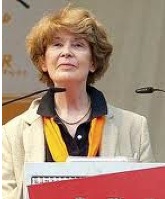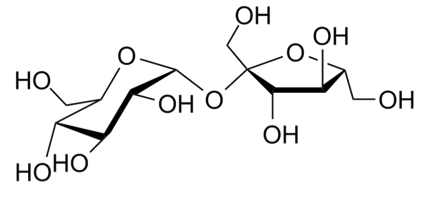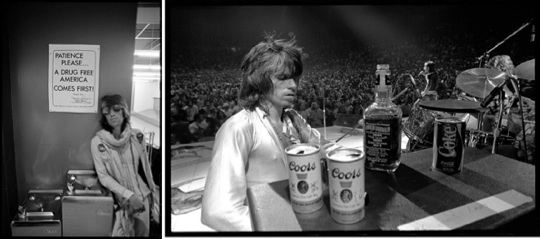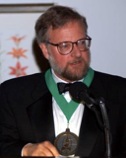2011 September blog
Geoffrey Cannon

'Either we achieve together a new level of human emancipation, and do so in a way that preserves the earth, or we shall leave behind us the worst future for our children that capitalism and nature can deal them. No one knows in which direction the balance will tip, nor does anyone know which actions, which writings, which alliances may achieve the critical mass that leads us one way or another, backwards or forwards. I am acutely conscious of the precariousness of our moment and my four much-loved grandchildren give me added resolve to address it'. Right now, all of us must be acutely conscious of the fragile state of world affairs. This is Susan George, my hero this month. The column ends with another salient statement by her, and some observation on the crucial importance to us of her work.
My first item below reflects on coffee from Brazil. My second item is part fiction and part fact. In the manner of Aldous Huxley's Brave New World or Jonathan Swift's A Modest Proposal, and indeed of Susan George's Lugano Report , the stories it tells may cast a dark light on current affairs. (The third of my four histories of what may be called the UK food and health movement of the 1970s and 1980s is held over to next month).
Food systems. Coffee
What is natural?

All the coffee in Brazil... Left to right, A 'coffee baron'; a modest version of the mansions built by coffee planters; coffee berries growing on the bush
My wife Raquel came into our house as I began to draft this column, with a basket full of raw coffee beans, like you see above, right. She had picked them from a bush in our 'forest plot' next to our house. This made me ponder on humans and nature.
James Lovelock, he of the Gaia hypothesis, was one of the first in modern times to propose that the living earth is a function of life itself. This idea has been developed by the Australian environmentalist Tim Flannery (1-3). He summarises evidence that the human species has had a much greater impact on the living and physical world than generally supposed. The Maori people who exterminated the gigantic flightless Moa birds. That's well known. Also, Tim Flannery proposes that it was the original human inhabitants who, soon after entering the Americas over the Bering land bridge 14,000 or so years ago, exterminated the native mammoths and mastodons and other big mammals, with all that implied for the landscape, as a prelude to the extermination of the buffalo in the late 19th century.
The lands we live on now, contain evidence of successive transformations. For instance, the condominium of 80 or so houses where I live in the state of Minas Gerais in Brazil, is on land which up to 200 or so years ago was part of what then remained of the Brazilian eastern forest, the Mata Atlântica. Before the Europeans came, this was as vast as is the northern Amazon forest. The speculators who created our condominium 20 or so years ago did not destroy the original forest. That had been done mainly in the middle and later 19th century in southern Minas Gerais, and also in the neighbouring states of Rio de Janeiro and São Paulo, to clear the hills and valleys to grow coffee, and to build mansions complete with Imperial palms and slave quarters.
A modest coffee planter's house is shown above. 'Coffee barons', such as the gentleman pictured above, left, sometimes became immensely rich. But the abolition of slavery in the late 1880s, market slumps in that period, and the global financial crash that began in 1929, bankrupted many coffee farm owners. Their workers left, to build shacks in city badlands in what became shantytowns (favelas). The coffee bushes rotted. Rain swept the soil on the hills into the valleys and rivers whose waters remain muddy to this day.
Our condominium was built on an abandoned coffee farm. We know this, because three coffee bushes survive in our 'forest plot' of secondary or tertiary growth trees, Raquel took her basketful to friends in the countryside. She is practical. It's good to know that the coffee berries that still grow here are being dried, roasted and ground by folks who retain these skills. In due course I will drink to that and them.
Thinking ahead to when the seas rise, the land heats, and the economies of North America and Western Europe have imploded, I dream of our son becoming self-sufficient as a farmer of coffee for local consumption. Or perhaps we should go deeper, grub up the bushes, plant the original species of trees on our forest plot, and try to reintroduce the creatures that lived here once and are now gone?
What then, about the original human inhabitants? Or should we go even deeper and discover what the land was like before any humans came? But where does that place us? Jim Lovelock and Tim Flannery are right. Humans are just one species, but we do belong here on earth. We just need to be a lot more thoughtful and careful. A good start will be to figure out how the global human population can be reduced from the current nearly 7 billion to say 3 billion (the number in 1960) by 2100, and thereafter continue to diminish in quantity.
References and note
- Flannery T. There ain't no more moa in old Aotearoa. [Chapter 18]. The Future Eaters. An Ecological History of the Australasian Lands and People. New York: Grove Press, 1994.
- Flannery T. Massacring the mammoth, dismembering the mastodon. [Chapter 15]. The Eternal Frontier. An Ecological History of North America and its Peoples. New York: Grove Press, 2001.
- James Lovelock and Tim Flannery are in good company. In our times, scientists and thinkers with comparable views include Lyall Watson, Rupert Sheldrake and Fritjof Capra. They descend from a line of 'vitalist' natural philosophers of which the most distinguished is Johann Wolfgang von Goethe.
Mastering the universe
Three scenes: Money, glory, power
The UN summit on prevention and control of non-communicable diseases takes place in New York this month. Its Political Declaration, which as I write is in final draft, has aspects which to an innocent eye seem strange. The obvious enthusiasm for partnerships with those sectors of the food and drink processing industry – including Big Snack and Big Booze – whose products, as consumed regularly in typical amounts, are an important cause of obesity and of serious diseases that are now pandemic, may well seem weird. And why the emphasis on screening and treatment, of little use in impoverished regions and countries except for the middle classes and the medical and pharmaceutical industries? What goes on, in whose interests, and why?
Much the same can be said of the UN Global Compact set up to promote collaboration with 'the private sector', including conflicted industry, and also the UN SUN Road Map initiative, part of whose plan is public-private partnerships, which in practice again mostly means transnational food processors. Big Snack and Big Booze, positioned as leaders in the fight against obesity and diabetes? You're kidding! But there it is, and there they are. Is there something going on here that is not yet well understood by trusting souls? Are the people formally responsible for the summit the people who are really calling the shots? A randomised controlled double blind crossover trial of masters of the universe is not feasible. We have to find other methods of investigation.
So follows a fable of genius acts of marketing, or GAM for short, in the form of two short scenes of what goes on behind the scenes. The period of history is the time when the political and economic ideology that became rampant as from the 1980s, took shape. The third story is not a fable. It happened.
Scene 1
Money. Think sizzle
Scene 1 is in Los Angeles, in the offices of Heigh, Bull and Sleight, the public affairs company affectionately known as the Higher Bullsh*t. It is the late 1970s.
Present are HBS directors Alvin ('Offhand') Sleight and Bill ('Raging') Bull, and Messrs Rod, Blynken and Wynken, the big bosses of what is now a leading transnational sportswear company, then about to go bust.
Nod reports that manufacture is now located in the New Territories outside Hong Kong, with workers on 80 hour weeks for the equivalent of $US 5 plus $US 5 in tokens redeemable at the company store. Good. Blynken reports that despite holding retail prices, sales are flat-lined. Bad. Wynken reports that 85 per cent of the runners in the first two five-borough New York marathons wore Other Stuff, rising to 93 per cent in 1977. Very bad. Silence. The air conditioning hums. A chair creaks.
Offhand rises to make the pitch, and flips a switch. The room darkens, a screen descends, and a pricey movie of the New York marathon is shown, except it's staged, with rent-a-runners, most wearing a RBW singlet or t-shirt with RBW on the back. A zoom-in shows words underneath: Rock Baby Win. Another long silence.
Blynken sighs. 'It would cost us our whole annual budget to pay for the athletes to wear that stuff, and the joggers wouldn't wear it even if we gave it away'. He makes a mental note to cancel the HBS contract. Raging says it's a great branding exercise, take a risk, give it time. Silence.
Then a quiet clear voice is heard. This is the HBS intern, Hedge Fox, just come down the #1 route from the Stanford Research Institute VALS (Values and Lifestyles) laboratory. She says 'Sizzle'. 'Ssh' says Raging. 'Go on' says Offhand, intrigued. 'Gentlemen' she says, 'you are talking substance. Think sizzle. First, the branding must be bolder and bigger, so it covers the chests and backs of the runners, like

And second, the gear must be sold at three times the price. It's a lifestyle must. We can go discreet with the branding after the impact hits'. 'Ha ha ha', chime in Rod, Blynken and Wynken. 'Get people to pay, and to pay lots more, to wear an advertisement for the product?' says Wynken. 'Don't be ridiculous. Ha ha ha, get out of here. Get people to pay us lots of money to advertise us, absurd'. Silence. The air conditioning hums. Offhand says 'But what if she is right? Gentlemen, remember HBS Maxim #7. What everybody knows can't work, may be the very thing that works best. s
Think sizzle. Money for GAM.
And the moral is...
So what's the moral of this fable? One concerns branding. Every time I'm in a street in Brazil and see people wearing advertisements, I know that some marketing genius, probably in the 1970s, had the counter-intuitive idea of getting people to buy advertising for branded products – that is, to wear and even to be the brand. Whenever I go to buy a t-shirt and say no, really, truly, I want a plain one, I think of this.
The power of massive marketing of branded processed products replaces that of religion. The image becomes the reality. Campaigns to reduce consumption of ultra-processed products, which are invariably branded, and to make healthy food the first choice, will succeed only if brands are suppressed, or else – let's be positive! – healthy food is branded. The young Londoners who last month smashed into shops and in their alienated rage torched buildings, did not loot fruit and vegetables, or higher-value foods like salmon or steak. Some stole booze. What they wanted – needed – was brand image goods like trainers. In our own work we also need to think sizzle.
Scene 2
Glory. Steer into the skid
Scene 2 is in Chicago, at the headquarters of VitaLife, an imaginary soft drink company. It is 1972. CEO Iman Bagasse, who allows his pet name to be used only by intimates, and his chairman Peter Sweetwater, who never allows jokes on his name, are in a stew.
'There's nothin' y'all can do 'bout this', says Bagasse, who is from Alabama, 'but them ****ers the limey band the Rollin' Stones are all over our sweet country and that ****er the addict keeps on getting himself pictured drinkin' The Product'.
'And there's this report from our research boys' says Sweetwater 'on The Product, saying...' (he clears his throat) 'Tests reveal significant steep-peak monophasic ingestion preference sequences correlated with esters of ethyl 2,4-hexadienoate', and when I asked our Prof FCF Blue what this meant, he said it meant that VitaLife is ADDICTIVE'. 'I know it!' says Bagasse. 'Here's the 2,4-Hex file' says Sweetwater. 'The rats we feed chow with this stuff added, they go nuts, gobble it up, won't eat anything else, tear each other apart fighting over it'. 'Just like us boys after a couple of quarts of Jack, eh', says Bagasse. 'Hold that thought' says Offhand.
'I know it!' says Bagasse, though he doesn't, not yet. 'An' there are all these frickin' eggheads saying that sugar is causin' tooth de-cay and what's it, dia-betes, you know what that is Pee, and sweet Jesus knows what else, oh yeah, that it makes you fat'. He flaps a hand at a two foot pile of research papers published in scientific journals, placed on the table. Bagasse says 'We're ruined, and I don't know why I am tellin' y'all this'.
'Peace, gentlemen' says Offhand, who Sweetwater had briefed a week before. 'Our task here is the big picture, on your behalf until 2000 and thereafter. First off, forget sugar. Think sucrose. Think carbohydrates, and I'm coming to that'. He shows a slide:

'Ho. ho, oh, oh' exclaims Bagasse, whose 25 years in the business has been on the practical side. 'What kind of friggin' joke is this?' 'It's the chemical structure of sucrose' says Sweetwater. 'Uh, well, who's to know?' 'That's the point' says Raging. It's boring, it's irrelevant, but it's information. What consumers, journalists, editors, the scientific community, politicians want, is information. So we give them truckloads of information. Now Bad, if I may' (Bagasse glowers) 'here's one that you will like':





'See them gear-wheels' says Bagasse, sticking a finger on the picture of an pre-industrial refinery above, 'niggers used'a get their hands caught in 'em. If the charge-hand was a rummy, darkie would go in right up to the shoulder. Even all the way through. Yes Sir, brown sugar eh, heh heh'. He has an estate on Barbados. 'Yes, well', says Offhand, 'we won't go into that. These pictures are part of a beautiful publicity piece that we'll ship in bulk to every school in the country and to every politician on The Hill'. His accent is moving south of the Mason-Dixon line. 'The Romance of Sugar' sighs Raging, who admires the Offhand style. 'Beautiful'.
'One more thing' says Offhand. 'In the scientific and all egghead and longhair context, "sugar" is banned. Never say "sugar". Say "su-crose". But in the literature don't even say "su-crose". Say "car-bo-hydrates". If pressed admit to "fermentable car-bo-hydrates". But never "sugar". 'But that's confusin' says Bagasse. Offhand smiles.
'Uh.oh, I see, keep 'em guessin'. But who are we... ?' Raging smiles. 'We've been talking to the Big Sugar boys' he says. They buy the idea. They're going to set up a foundation. The Universal Well-Being Fund. Say 'UWellBe'. VitaLife is offered founding membership with you as Senior Vice-President (Global Affairs). It's capitalised with $50 million. The Fund will offer grants for 20 university departments of car-bo-hydrate metabolism. That'll keep the boffins out of harm's way'.
Bagasse looks pleased. But he remains agitated. 'What the **** has all this got to do with them steep-peak whatnots that Brilliant – our boffin Pro-fessor FCF Blue – says are AD-DICTIVE?' he asks, voice rising. 'Here's what you do' says Raging. 'You have dinner with him and his sweet wife and you say "Brilliant, I'm making arrangements to transfer some stock to you, and the board would like you to accept an offer of" – say, 50 per cent more than he's getting. When he finds out that the value of the stock is $10 million, you bring him into your office here. You congratulate him on identifying the delightful stimulating exciting more-ish agent in The Product (remember "more-ish"), slam a patent on it, and give him the go-ahead to reformulate so every doggone can of VitaLife contains twice the amount of 2,4-Hex'. We could try 'Go go go with Vita-Life. We could re-brand it as Zoom, or RocketFuel'.
'Remember HBS Maxim #4' says Offhand. Steer into the skid'. 'Don't hide it. Boast about it. Advertise it with the jingle 'I put a 2,4-Hex on you'. Sung by the Rolling Stones. Cut from Jagger with the mike to Richards with The Product, the image looking like this' (he shows the picture at left, below).

'And now this' (he shows the picture at right, above). 'Except that the products are Our Product, right?' says Sweetwater. 'You got it, babes' says Raging. 'We'll have the President of the US of A drinking The Product on television any time he wants the votes of the under-25 demographic'.
'Genlmen, you may indeed call me Bad' says Bad. 'Pee, that's the mostest Bad Ass idea I ever did hear, God damme, sweet Jesus, Mary and Joseph, yes Sir'.
Steer into the skid. Glory for GAM.
And the moral is...
A moral of this story is that for many of us, what's bad is good. Maybe this is a universal human trait. As a young advertising agency copywriter, Salman Rushdie invented the slogan for a brand of cream cake: 'Naughty but nice'. Campaigns telling people what's good for them, don't work. Also, with any ultra-processed product, soft drinks being one example, what you may think you are getting is not what you are actually getting, Further, you won't be helped much by the label or by what's said in dietary guidelines.
We go shopping – or with ultra-processed products, go into or up to almost any retail outlet – and see what we see, and buy and use or consume. Usually we do not think about what's behind these actions, known as choices. What is going on is the result of genius acts of marketing, that manipulate the desires especially of young and vulnerable people so that they can imagine that their life is good, and also that find ways of legitimising addiction. Governments want you to behave like this, too. The more that a country's population buys, the greater the national turnover and therefore the gross national product, and therefore the more 'developed' the country is. So think on, before you buy a product, and also before you swallow a line being dangled in front of you.
Scene 3
Power. The Good Club
My scene 3 was also going to be fictional. I had set it in New York in 2003, and had invented a meeting of a mix of real and imaginary people. The idea being, that it is at such secret meetings that the masters of the universe make agreements that, as if by magic, become UN and national government policies and actions.
My intention was to conclude with a moral that relates directly to this month's UN NCD Summit. The people we all see making agreements on television, and in on-line and print stories, may or may not be the people who actually make the plans and take the decisions. After all, we know – don't we? – that world political as well as economic policies really are hashed out at meetings of organisations like the World Economic Forum, and there is no way that the media-released speeches are all that goes on at Davos. We are not that naive! So I thought that the only way to suggest that there is quite a lot more to international policy-making than what is publicly available, was to make up a fable. Hence my imaginary Scene 3.
This happened
No need! See Box 1. This is all true. It's about a meeting in New York that was meant to be secret. The host was Paul Nurse, the president of the UK Royal Society. The other members of the meeting were multi-billionaire US citizens. They were entertainment moguls Oprah Winfrey and Ted Turner (of CNN, inventor of 24/7 rolling news); close friends and colleagues Bill Gates and Warren Buffett; the younger David Rockefeller (whose father helped to found the Bilderberg Group); the Hungarian-born speculative financier George Soros (best known as 'the man who broke the Bank of England'); and Michael Bloomberg (owner of the world's most influential financial services company, now mayor of New York). Moreover, somebody leaked. It's known what they discussed and agreed. See Box 1.
Box 1
The Good Club







The Good Club: Paul Nurse, Oprah Winfrey, Bill Gates, Warren Buffett,
David Rockefeller, George Soros, Michael Bloomberg, and Ted Turner
John Harlow reported as follows in June 2009, in The Times, and then in The Wall Street Journal.
Some of America's leading billionaires have met secretly to consider how their wealth could be used to slow the growth of the world's population and speed up improvements in health and education. The philanthropists who attended a summit convened on the initiative of Bill Gates, the Microsoft co-founder, discussed joining forces to overcome political and religious obstacles to change.
Described as 'The Good Club' by one insider, it included David Rockefeller Jr, the patriarch of America's wealthiest dynasty, Warren Buffett and George Soros, the financiers, Michael Bloomberg the mayor of New York, and the media moguls Ted Turner and Oprah Winfrey. These members, along with Gates, have given away more than £45 billion since 1996 to causes ranging from health programs in developing countries to ghetto schools nearer to home.
Not a global cabal
They gathered at the home of Sir Paul Nurse, a British Nobel prize biochemist and president of the private Rockefeller University, in Manhattan on 5 May. The informal afternoon session was so discreet that some of the billionaires' aides were told they were at 'security briefings'. Stacy Palmer, editor of the Chronicle of Philanthropy, said the summit was unprecedented. 'We only learnt about it afterwards, by accident. Normally these people are happy to talk good causes, but this is different – maybe because they don't want to be seen as a global cabal', he said.
Some details were emerging, however. The billionaires were each given 15 minutes to present their favorite cause. Over dinner they discussed how they might settle on an 'umbrella cause' that could harness their interests. The issues debated included reforming the supervision of overseas aid spending, to setting up rural schools and water systems in developing countries. Taking their cue from Gates they agreed that overpopulation was a priority.
Gates, who is giving away most of his fortune, argued that healthier families, freed from malaria and extreme poverty, would change their habits and have fewer children within half a generation. At a conference in Long Beach, California, last February, he had made similar points: 'Official projections say the world's population will peak at 9.3 billion [up from 6.6 billion today] but with charitable initiatives, such as better reproductive healthcare, we think we can cap that at 8.3 billion',he had said.
Not a world government
Another guest said there was 'nothing as crude as a vote', but a consensus emerged that they would back a strategy in which population growth would be tackled as a potentially disastrous environmental, social and industrial threat. 'This is something so nightmarish that everyone in this group agreed it needs big-brain answers', said the guest. 'They need to be independent of government agencies, which are unable to head off the disaster we all see looming'.
Why all the secrecy? 'They wanted to speak rich to rich without worrying anything they said would end up in the newspapers, painting them as an alternative world government', he said.
So Bill Gates believes that 'we' can cap the world's population at a billion less than projected. Wow!. Maybe the plan will involve distribution of contraceptives. Is this why, with the acquisition of the Hathaway shares donated by Warren Buffett, the Gates Foundation is becoming the largest single shareholder in Coca-Cola? For the Coke distribution network reaches deep into the remote rural interiors of impoverished countries. Perhaps condoms could be strapped to the cans. Perhaps the formulation of the drink could be… no, no, let's not go there… But there again, let's think Big Picture, why not? That would indeed be a Genius Act of Marketing.
And the moral is…
The moral? Am I implying that the Good Club is bad? This is not my point. Self-made billionaires are usually very smart, and are entitled to meet and hash out ideas, though a plutocracy of super-rich people with a shared political and economic ideology does have a sinister side. My point is that the decisions that shape our lives are increasingly not in the hands of elected officials, and that what actually goes on is increasingly kept out of the public domain. This is not a new thought. But perhaps now, you are no longer wondering why the UN Secretary-General and the heads of UN agencies are so enthusiastic about 'public-private partnerships' with transnational manufacturers of ultra-processed products. When you read all about the outcome of the UN NCD summit, it's worth bearing this point in mind. Follow the money, glory, and power.
Susan George
Yes, another world is possible
The greater part of industrialized country establishments and that heterogeneous beast called the 'international community' are immune to moral suasion and human suffering. They will not raise a collective finger to alter the situation of millions of hungry people in any meaningful way, unless they fear their vital interests are at stake or unless forced to do so by public pressure….
Up to now, the centres of the developed (dominant) countries have largely had their own way in running the affairs of the world – in cooperation, where necessary, with the centres of the underdeveloped (dominated) countries. … If past experience is any guide, the centre-to-centre connection will only aggravate and perpetuate hunger. Hope lies in the number and the strength of links that can be forged between 'ordinary people'… and the pressures that these same 'ordinary people' can bring to bear on their governments and on the 'international community'. An end to hunger depends on how many of us refuse to tolerate the intolerable.
Susan George, 1933 –
How the Other Half Dies. The Real Reasons for World Hunger, 1986 (1)
Susan George's work continues to have an impact on thinking about international development that is comparable with that of Rachel Carson's Silent Spring on thinking about agribusiness. There are three differences. Now in her mid 70s, Susan George is with us and active; she is organised, within the Transnational Institute; and she maintains, in the words of the World Social Forum, that yes, another world is possible. She often quotes Antonio Gramsci on the need for 'pessimism of the spirit, optimism of the will'.
She is already a hero within our profession. For the special issue of Public Health Nutrition on the New Nutrition Science (2), the members of the working party responsible for the Giessen Declaration were asked what writers have most influenced them. Susan George came top of the poll, followed by Amartya Sen. Her first book (1), a tract on the causes of world hunger, written in controlled rage after the 1974 Rome World Food Conference, is also perhaps her most inspiring. Her work shows us why, to be effective, we need to understand the social, economic, and political, causes of health and disease – and poverty and hunger – and always be guided by principles of equity and justice (3-6).
In her oration on receiving an honorary doctorate in Spain in 2007, she said: 'I believe that the forces of wealth, power and control are invariably at the root of any problem of social and political economy. The job of the responsible social scientist is first to uncover these forces, second to write about them clearly, without jargon, in order to give ordinary people the right tools for action; and finally – recognising that scholarly neutrality is an illusion – to take an advocacy position in favour of the disadvantaged, the underdogs, the victims of injustice'.
References
- George S. How the Other Half Dies. The Real Reasons for World Hunger. London: Penguin, 1976.
- The New Nutrition Science. Public Health Nutrition 2005; 6(A): 667-804.
- George S. Ill Fares the Land. Essays on Food, Hunger, and Power. Washington DC:Institute for Policy Studies, 1984.
- George S. A Fate Worse than Debt. A Radical Analysis of the Third World Debt Crisis. London: Penguin, 1988.
- George S. The Lugano Report. On Preserving Capitalism in the 21st Century. London: Pluto, 1999.
- George S. Another World is Possible If... London: Verso, 2004.
Acknowledgement and request
You are invited please to respond, comment, disagree, as you wish. Please use the response facility below. You are free to make use of the material in this column, provided you acknowledge the Association, and me please, and cite the Association’s website.
Please cite as: Cannon G. What is natural? and other items. [Column] Website of the World Public Health Nutrition Association, September 2011. Obtainable at www.wphna.org
The opinions expressed in all contributions to the website of the World Public Health Nutrition Association (the Association) including its journal World Nutrition, are those of their authors. They should not be taken to be the view or policy of the Association, or of any of its affiliated or associated bodies, unless this is explicitly stated.
This column is reviewed by Fabio Gomes, and also by Claudio Schuftan, to whom thanks for reminding me that truth is more revealing than fiction.






